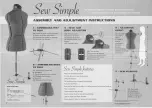
Wireless Rotary Motion Sensor
Experiment 2: Rotational Inertia of Disk and
18
013-15949A
Procedure
Measurements for the Theoretical Rotational Inertia
1.
Weigh the ring and the disk to find their masses and record these masses in Data Table 1.
2.
Measure the inside and outside diameters of the ring and calculate the radii,
R
1
and
R
2
. Record in Data Table
1.
3.
Measure the diameter of the disk and calculate the radius,
R
, and record into Data Table 1.
Data Table 1: Theoretical Rotational Inertia.
Setup
1.
Mount the Wireless Rotary Motion Sensor
(WRMS) on a support rod.
2.
Mount the Super Pulley with Clamp on the
side of the WRMS as shown in Figure 2.3.
3.
Tie one end of a thread to a Mass Hanger
and the other end of the thread to one of the
levels of the 3-step Pulley on the RMS.
4.
Drape the thread over the Super Pulley such
that the thread is in the groove of the Super
Pulley and the Mass Hanger hangs freely.
5.
Adjust the Super Pulley with Clamp to an
angle so that the thread runs in a line tangent
to the point where it leaves the 3-step Pulley
and is straight down the middle of the groove
on the Super Pulley.
6.
Remove the thumbscrew from the 3-Step
Pulley. Place the disk directly on the
square-shaped top of the 3-step Pulley as
shown in Figure 2.3.
7.
Place one of the disk alignment guides on the
disk. Replace the thumbscrew to the 3-Step
Pulley so that the disk alignment guide is
firmly held in place.
8.
Place the thin ring on the disk alignment guide on top of the disk as shown in figure 2.3..
Mass of ring
Mass of disk
Inner radius of ring
Outer radius of ring
Radius of disk
Figure 2.3: Rotary Motion Sensor
Setup and Free Body Diagram
Super Pulley
with Table
Clamp
Hanging
mass
Disk
Wireless Rotary Motion
Sensor with 3-step
Pulley
Thin
Ring
T
mg
a
Disk Alignment
Guide






































